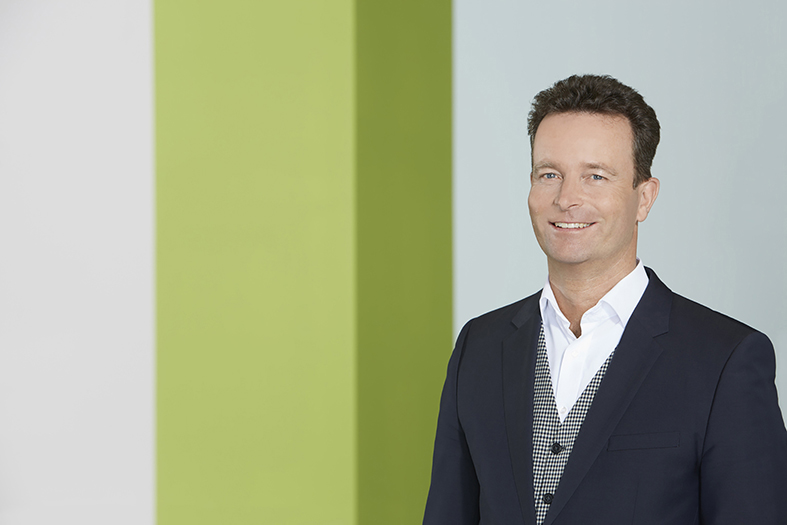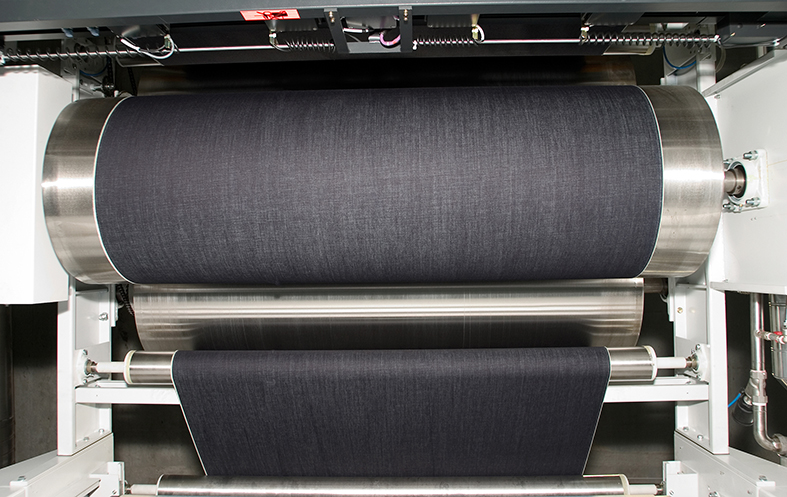A company that specialises in machines for finishing textile and film webs, BRÜCKNER Trockentechnik GmbH & Co. KG introduced assistance systems for plant operators into the market. The family-owned company, an active member of VDMA, expects the tools to unlock energy savings and free up 30 per cent of the reserve capacity in German-manufactured systems. In some cases, retrofits are also possible.
Mr. Axel Pieper, Technical Director, gives details about BRÜCKNER’s potential in an exhaustive interview.
Excerpts:
ITMA 2015 featured the issue of sustainability very prominently. How is BRÜCKNER working on the issue of sustainability?
We introduced new machine concepts, and continue our dialogue with long-standing and new customers alike. The themes we emphasised at the trade fair were reduction of resource consumption and machine productivity. One very new item in this field is energy management software package with integrated assistance system for machine operators. With this innovative package:
(1) All energy consumptions such as gas, electricity and water can be logged and analysed subsequently per batch, per shift, per period in use.
(2) The material data and finishing parameters can be used to calculate optimum machine setting values, in order to minimise energy requirements and/or maximise productivity.
(3) Ideal profiles can be worked out and stored, and then compared with the production parameters actually run on the machine. The difference between reference and actual (waste) is logged and is analysed later for each batch, shift and period in use.
(4) The data obtained in this way then serve as the basis for determining how much energy is was wasted as a result which machine settings. This can be done either after the fact or while production is ongoing.
In order to optimise energy consumptions, Brückner is dabbling with influencing factors that are not necessarily of primary concern for most manufacturers…
Exactly, and that is the human factor, or more precisely, the machine operators. With regard to the productivity of machinery systems, there are three influencing factors, all of them more or less equally important: the efficiency of the machine, servicing and cleaning the machines, and the process expertise of the machine operators. Most manufacturers, including us, have already optimised the first two, but the human factor is still very often disregarded. “If the operating personnel do not have adequate understanding of the process, it’s like driving a Ferrari only in second gear.” It follows that the machine operators must be given the tools that enable them to drive the machinery properly, and to maintain it.
Where does Brückner start this process for dry finishing?
Brand new and the prototype was ready for ITMA: We provide the operators with intuitive assistant systems, optionally in the form of an actual tool, which is supported by the databases that hold the sum of our own process knowledge. Then, the machine operator only has to enter the key information for the goods, such as weave type (e.g., wovens), fibre mixture (e.g., 100% polyester), weight of goods (e.g., 150g/m²), then the moisture content at start (e.g., 60%) and the process (e.g., setting wet fabrics). With the new simulation tool, in the next step the entire cycle can be simulated. When it is finished, the system offers works out as series of suggested measures according to two optimisation criteria: large volumes in the shortest possible time or energy-optimised production.
That’s the theory, how does the software work in practice then?
The optimum profile can be calculated either on an office PC by the job preparation department, or right at the machine by the operator himself.
Alternatively, existing profiles can also be checked by the assistance system with regard to the criteria of maximum productivity and/or minimum energy consumption. In this case, the machine will be “run as it always has been” and the operator simply enters the fabric data (see above) in the machine controller. The assistant system works in the background and shows the operator where there is potential for further optimisation in a traffic light format. In practice, this could be, for example: “Run the dryer faster, because otherwise you are drying too much”, or “Reduce the fan power in the heat setting zones”, and so on. In a large-scale process, this has the potential to substantially increase productivity and/or save energy. But all of that taken together is only really half of the possibilities.
… and the other half?
Comes from the internal comparison between system operators or entire shifts, and whether the textile finishing according to the productivity guidelines was really carried out in line with optimum energy criteria at all times as well. For example, was the night shift as productive and economical with resources as the day shift? In the next step on the road to 360 degree energy management, the maintenance condition of the machines can be monitored with special sensors. Then it would be possible to document the first signs of dirt accumulation or wear over the timeline as well as the time until the next scheduled cleaning or part replacement. So the customer can prove that he always kept the machine well maintained, and consequently production was as energy efficient as possible.
An existential energy question: What effects would these assistance systems have?
In dry finishing with our equipment, the effects could be huge. Because when we consider our systems, of which there are now over 5,000 in service all over the world, it is highly likely that many of them are only being run at half of their technically possible capacities. The reasons for this are to be found in maintenance and operator expertise. Looked at another way: When a customer wants to find ways to double his production capacity, he does not necessarily have to invest in a new machine to do it. Our new assistance systems have proven capable of getting about 30 per cent more output from the existing machinery. It is planned to offer this tool as a retrofit as well, depending on the machine generation.
Brückner seems to be positioning itself more and more as a special machine manufacturer. Is this true?
We have two core product lines, our production facilities are exclusively in Germany, for reasons of conviction and maximum flexibility: About 70 per cent of our business is still rooted firmly in the classic textile machinery sector, and we have developed modular systems for that. The revenue from this sector is our “bread and butter” if you will, and it is what allows us to devote the other 30 per cent to our technically demanding, complex special applications for technical textiles, nonwovens and other types of goods. In these areas, no two systems are alike.
Please give us some examples.
For instance, a manufacturer of spunlace nonwovens needed a dryer with integrated heat recovery systems that could evaporate five tons of water per hour as efficiently as possible in terms of energy expenditure. Our customers in the technical textiles field are usually very specific about their requirements. One wants to manufacture ultrasensitive tissues for blood filtration, another makes superstrong filters for nuclear power plants. Yet another wants to coat the foil on sticking plasters, and another intends to apply a coating to extremely hard-wearing toothed belts for conveyor systems. We are also the ideal partner when it comes to solvent coatings and high temperature applications. For these purposes, we are building continuous furnaces with operating temperatures up to 450 degrees Celsius, so we can burn oils and blackwash off from an electronic glass fabric in a continuous process, for example. These fabrics are used as a component in printed circuit boards.
How does Brückner respond to new challenges, relating to technical textiles, for example?
The area of possible applications in Medicine is currently of very high interest to us in this regard. In the last few years we have designed a number of special machines for medical textiles, and they have been put into operation successfully. For example, system concepts have been put into practice for drying, heat setting, functionalising and coating medical textiles such as gauze and compression bandages, sports and kinesiology tapes and blood and dialysis filters. At the moment, we are in the process of designing from scratch a system for coating elastic, transparent special plasters and bandages with silicone. For another project we are developing a special tensioning and winding machine for elastic bandages. By their nature, medical technology applications are subject to extremely stringent hygiene requirements, which means that these special machines are also built using mainly special plastics and stainless steel grades.
One last question, about future market opportunities, looking towards India and Bangladesh…
… There is still a great deal for us to do in these regions. A good example of this would be Iran. Just recently, as part of a VDMA market development event, we delivered a presentation on innovative technologies and heat treatment of textiles for Iranian investors and industry experts.
Since the election of the new government in India, the market we were able to service much more effectively ten years ago has shrunk again somewhat. We are still hoping that the announced plans to develop the base for technical textiles will come to fruition. Unfortunately, they are still driving with the handbrake on in this regard.
A delegation of textile finishers from Bangladesh, our long-standing customers, recently visited our technology centre in Leonberg to learn about our new generation of dryers. Then, various coating experiments were conducted with our extremely flexible application unit OPTI-COAT. This enables precise application quantities to be spread on an enormous range of coating types.
The BRÜCKNER Group (365 employees, 80 million euro in sales in 2014) is an owner-managed, medium size corporation still in the hands of the founder’s family, with head office in Leonberg, Baden-Württemberg. The company has developed, manufactured and sold BRÜCKNER machines and machine systems for coating and finishing textiles, technical textiles, nonwovens and floor coverings for more than 65 years. These machines – often custom solutions to satisfy special customer requirements – are built exclusively at the company’s production facility in Tittmoning, Bavaria. More than 5,000 of the company’s machines are in operational use worldwide. With an export quotient of over 90 per cent, BRÜCKNER is a technology and market leader in its segment. The new technology centre in Leonberg can also be made available to customers who wish to test goods, create new and develop existing products.
“If the operating personnel do not have adequate understanding of the process, it’s like driving a Ferrari only in second gear.”
– Mr. Axel Pieper, Technical Director, BRÜCKNER Trockentechnik

